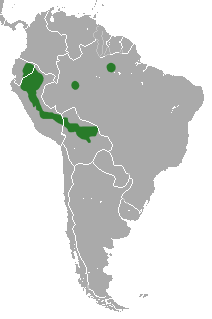Bushy-tailed opossum facts for kids
Quick facts for kids Bushy-tailed opossum |
|
|---|---|
 |
|
| Conservation status | |
| Scientific classification | |
| Genus: |
Glironia
|
| Species: |
venusta
|
 |
|
| Range of the bushy-tailed opossum | |
| Synonyms | |
|
G. aequetorialis H. E. Anthony, 1926 |
|
The bushy-tailed opossum (Glironia venusta) is a type of opossum found in South America. It was first described by a scientist named Oldfield Thomas in 1912. This opossum is a medium-sized animal. It has large, dark, oval-shaped ears and a coat that can be fawn (light brown) to cinnamon colored. Its belly is usually buff (pale yellow-brown) or gray. Its limbs are grayish, and it has a very furry tail, just like its name suggests!
We don't know much about how the bushy-tailed opossum behaves. Scientists have only studied fewer than 25 of them. It seems to live in trees (this is called arboreal). It is also nocturnal, meaning it is most active at night. It probably lives alone. Its diet likely includes insects, eggs, and parts of plants. This opossum has been found in thick, wet tropical forests. It lives in countries like Bolivia, Brazil, Colombia, Ecuador, and Peru. The IUCN (a group that checks on animal populations) says it is of least concern, which means it's not currently in danger.
Contents
What is a Bushy-Tailed Opossum?
The bushy-tailed opossum is the only member of its group, called Glironia. It belongs to the Didelphidae family, which includes many types of opossums. The scientist Oldfield Thomas first described it in 1912.
The name Glironia comes from two older words. Glir is a Latin word for "dormouse," and -ia is a Greek ending that means "quality" or "condition." So, it's like saying "dormouse-like." The second part of its name, venusta, is a Latin word meaning "charming."
How Does it Look?
The bushy-tailed opossum is a medium-sized animal. It has big, dark, oval ears. Its fur is usually fawn or cinnamon brown on its back, and buff or gray on its belly. Its legs are grayish. As its name tells you, it has a very furry tail!
Its face has two bold, dark stripes. These stripes go from the sides of its nose, through its eyes, and all the way to the back of its ears. A thinner grayish-white band runs between these dark stripes, from its nose to the back of its neck. Its fur can feel soft or woolly.
This opossum does not have a pouch like some other marsupials. Its tail is about 19.5 to 22.5 centimeters (about 7.7 to 8.9 inches) long. The tail gets darker and less bushy towards the end. The tip of the tail might be completely white or have some white hairs mixed in.
The head and body of the bushy-tailed opossum are usually between 16 and 20.5 centimeters (about 6.3 to 8.1 inches) long. Its back feet are about 2.7 to 3.1 centimeters (about 1.1 to 1.2 inches) long. Its ears are about 2.2 to 2.5 centimeters (about 0.9 to 1 inch) long. It weighs around 140 grams (about 5 ounces).
Where Does it Live and What Does it Do?
We don't know much about the bushy-tailed opossum's daily life. Scientists have only found and studied a small number of them, fewer than 25 in total.
Studies of its body suggest it is very good at moving powerfully through trees. This means it is an arboreal animal, spending most of its time in trees. It seems to be a solitary animal, meaning it lives alone. It is also nocturnal, so it is active mainly at night.
One opossum was seen running and jumping through vines, just like other opossums do. It was probably looking for insects to eat. Its diet is likely similar to that of mouse opossums. This means it eats insects, eggs, and plant material.
Where Can You Find It and Is It Safe?
The bushy-tailed opossum has been found in thick, wet tropical forests. It has never been seen outside of these forest areas. It can live at high altitudes, up to 5 kilometers (about 3 miles) above sea level.
Its exact living area is not fully known. However, specimens have been collected from different parts of Bolivia, Brazil, Colombia, Ecuador, and Peru.
The IUCN (International Union for Conservation of Nature) lists the bushy-tailed opossum as least concern. This means it is not currently considered endangered. This is because it lives in a wide area, and scientists believe its population is large. The main threats to this opossum are when forests are cut down (deforestation) and when humans build new settlements.
Images for kids
See also
 In Spanish: Zarigüeya de cola de pincel para niños
In Spanish: Zarigüeya de cola de pincel para niños




